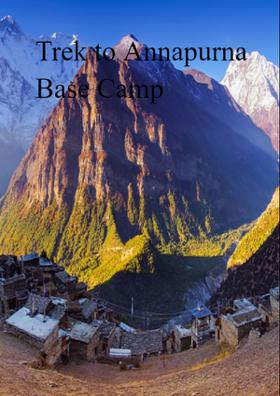Trek to Annapurna Base Camp
Trek to Annapurna Base Camp


Annapurna is a massive mountain range in the Himalayas in the north-central part of Nepal which includes numerous peaks with various heights.
One of the peaks of the Annapurna range towers over 8,000 meters (26,000 ft), thirteen of the peaks over 7,000 meters (23,000 ft), and sixteen peaks over 6,000 meters (20,000 ft). The mountain range is 55 kilometers (34 mi) long and is bound by the Kali Gandaki Gorge on the west, the Marshyangdi River on the north and east, and by the Pokhara Valley in the south. At the western end, the range encloses a high basin called the Annapurna Sanctuary. Annapurna I Main is the tenth highest mountain in the world at 8,091 meters (26,545 ft) above sea level.
The walk up to the Annapurna Base Camp is a classic trip right into the heart of the mountains. Annapurna Base Camp (ABC) is one of the most popular adventure treks in Nepal and is a quite easy and shorter trek when compared with the other high altitude treks in Nepal. The Annapurna Base Camp trek promises to indulge you in an amazing walk through a diversified landscape complete with a scenic mountain view, amidst terrace farms, traditional Gurung villages and a wide variety of flora and fauna. And when you reach the base camp you will be surrounded by soaring Himalayan peaks.
Furthermore, the route to Annapurna Base Camp takes us through a trip via the majestic Mt. Machhapuchhre (meaning 'fishtail'). So, you are able to visit two base camps in one trip! (How about that?) At times, you may even spot high cascading waterfalls on the way to the camp. Depending on the route you take, you might come across the Ghandruk museum where you can learn about the diverse culture of the Gurung community too.
Other major highlights of the Annapurna Base Camp trek are hot water springs, where you can relax and heal your aching muscles.
A trek to the Annapurna Base Camp can be taken at any time of the year, but the monsoon may not be the right time to visit the location due to heavy rainfall. So you might miss out on the grandeur view of the surroundings and whats worse? Leeches and mosquitoes, and possibly landslides and definitely slippery roads might make your trek an unnerving experience. Despite the fact that the monsoon brings about much discomfort in your agenda, animals are actually very active during this time of the season. So, if you are a keen animal activist and looking to study the surrounding fauna, Monsoon may be the right time for you.
But for those looking for a peaceful trek to the Annapurna Base Camp, Autumn is the best time to take the journey. Autumn is a time of the dry season and clear skies with bearable weather conditions, therefore it is very crowded during this time. December is also a good time to take the Annapurna Base Camp trek and is likely to be quieter at this time. Since it's going to be chilly or even cold, appropriate packing is advised to suit the weather. January may disrupt your trek due to avalanches while trekking along the route of Deuralli to Machhapuchhre base Camp. The area is prone to avalanches. Spring is another good season to go for an Annapurna Base Camp trek, but do understand the forecast for probable avalanches before you take the trip. In spring, the trail will witness with red and white rhododendrons blooming along the way and many other exotic flowers found in this region. Definitely, a good time to go for botanists.
The first day we have a briefing and sightseeing day in Kathmandu, where we can make sure that your kit is what you need and help you to get anything in the shops of bustling Thamel where our office is based. Then we’ll fly to the beautiful second city of Neal, Pokhara, and begin our trek’s itinerary. We pass through villages of several cultures as well as forests and rhododendron and picturesque Nepali agricultural villages.
The trekking is on good trails, with some rockier stretches nearer to our destination but nowhere is this climbing or even scrambling – there are good paths all of the way. You can expect to trek for 4 to 6 hours each day, with some days spent resting and acclimatizing to ensure that we are all fit and healthy at altitude. This makes the trek suitable for any averagely fit walker. On the route accommodation is in Nepal’s famous tea houses – the accommodation is basic but comfortable and the friendly, hospitable Nepali people make your stay a memorable one.


























